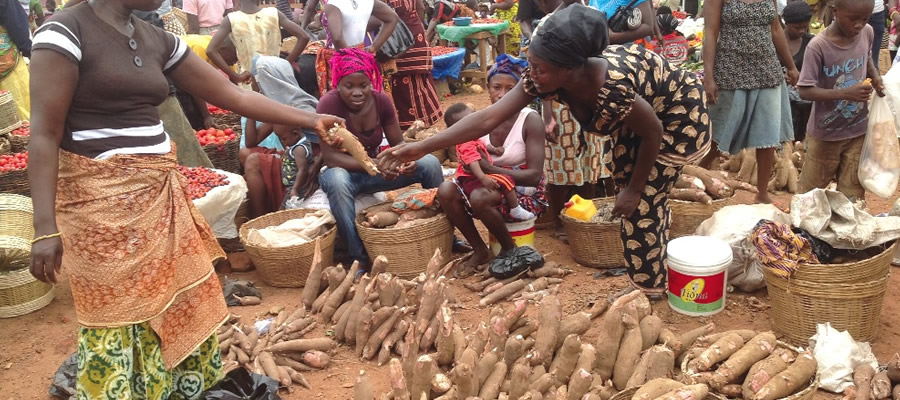

Traditional System of Governance
Traditional leaders - This is made up of the Traditional Council and several Chiefs and Queen mothers. They are the custodians of the culture of the people. This describes the established structures and processes which promote and guide development in the District. There are two main systems of governance in the District. These are the traditional system with established Chiefs and Queen-mothers presenting communities or clans.
The District traditional governance is led by the paramount chief called Kornor who is resident at Odomasi-Krobo and over sees all the communities in the District. He however has divisional chiefs, the Wetsomantsemei present in communities all over the District. Directly below the divisional chiefs are the sub-chiefs called Asafoatse and Dademantsemei (farming chiefs) and the elders and Queen-mothers. Also significant in the hierarchy are Clan Heads and family elders. The next in the hierarchy are opinion leaders of various tribes who mostly represent various interest groups in the communities. These people play various roles in the management of development projects and fostering peaceful co-existence in the various communities.
Institutional Framework for Local Governance
The various legal frameworks which guide local development in Ghana includes: The Civil Service Law, 1993 (PNDC Law, 327), the National Development Planning System Law, 2016, (LI 2232) and the Local Governance Act, 2016 (Act 936). These enactments place emphasis on District Assembly in order to reinforce the attainment of total decentralization and participatory development
According to National Development Planning System Law, 2016, (LI 2232), all District Assemblies are to submit District Development Plans to the Regional Coordinating Councils which will in turn harmonize the plans with the national development policies and priorities for consideration and approval by the National Development Planning Commission.
There is therefore a vertical relationship between the National Development Planning Commission at the National level, Regional Planning Coordinating Council at the Regional level and the District Assembly at the District level. The figure below shows the New
Local Government Structure
The Central Administration
It sees to the day-to-day management of the District and it consists of the following functional units:
General Administration /Services (i.e. Human Resource and Records Management, Secretarial Services etc)
Environmental Health and Sanitation
Works and Estate Management
Finance (Accounts, Stores and Revenue)
Local Government Inspectorate/Internal Audit,
District Planning Co-ordination Unit (Development Planning, Budgeting, Monitoring and Evaluation)
Client Services/Public Relations
Management and Decision-Making Process:
The General Assembly, made up of the People’s Representatives, constitutes the highest decision making body in the district. It deliberates on all important issues affecting the District, approves of settlement schemes/Medium Term Development Plans, Annual Budgets and Action Plans, etc.
Sub-Committees, initiate Policies of the Assembly and submit them to the Executive Committee for review and then to the District Assembly for approval.
Office of UMKDA (DCE AND staff), Implements Central Government Policies and Assembly’s programmes and resolutions.
Sub-District Structures
Town/Area Councils are instrumental in local level development. The District has Six Area Councils (Asesewa, Sekesua, Ternguanya, Mensah Dawa, Konkoney/Sisiamang and Bisa/ Anyaboni) and several Unit Committees. These structures are responsible for development activities at the lowest local level Table 1.25 show the area council analysis.
Despite their importance, the operations of these sub-district structures are virtually nonperforming due to inadequate financial support, logistical, lack of office accommodation and human resources capacity challenges. The relevant staff required to manage the operations of the councils are non-existent. The few staff available to manage these local councils have very little training to enable them carry out their day to day operations coupled with the absence of office accommodation.
payment of commensurate allowances by the District Assembly. The remaining sub-structures also needs to be trained and assisted to identify their needs and prepare a development plans. Even though needs assessment were conducted and validated during the preparation of this document the need to assist the Area council to development community plans to guide their development agenda in line the District’s and national agenda is necessary.
Social Accountability and Participation
The efficient use of resources requires that projects and programmes undertaken by the District Assembly are beneficial and relevant to the people. Consultation and participation of the intended beneficiaries can ensure efficiency and effectiveness in resource allocation. Participation also serves as an important monitoring and accountability mechanism as it has the power to assess the impact of programmes and projects undertaken in the District.
The level of citizen’s participation in the District varies with respects to the subject matter and also a number of factors like the benefits to be gained (immediate or future) from the issue under discussion, the availability of appropriate mechanism that allows community members to participate in issues that concern them. Therefore, appropriate communication channels must be put in place to allow persons or individuals irrespective of their political background, religious and ethnical affiliation to contribute to the development of their communities, district and the nation at large.
Date Created : 4/4/2019 5:13:56 AM










 facebook
facebook
 twitter
twitter
 Youtube
Youtube
 +233 593 831 280
+233 593 831 280 0800 430 430
0800 430 430 GPS: GE-231-4383
GPS: GE-231-4383 info@ghanadistricts.com
info@ghanadistricts.com Box GP1044, Accra, Ghana
Box GP1044, Accra, Ghana